#paleoecology
Text
I Love Prehistoric Ecosystems So Much
yeah individual taxa are cool and everything but no species is an island. What did it live with? What did it eat, what ate it? Did it have "friends" (term used loosely)? What was the environment like, where did they get water, what was the climate?
Tell me the whole story
Tell me how they lived
6K notes
·
View notes
Text
The earliest cities in Europe were built on the foundations of a mostly vegetarian diet, according to new research. The findings suggest that even with the dawn of agriculture and large, planned settlements, meat was but a delicacy.
The gigantic circular cities of the Trypillia culture emerged around 6,000 years ago in what is now Ukraine and Moldova.
Continue Reading.
101 notes
·
View notes
Text
i think we need a series of documentaries for people who ALREADY know a bunch about the topic. like i 100% love the ones like “our planet” that make science accessible and interesting, but they have to take 30 minutes to explain what evolution is. i want some that ARENT afraid to be jargony, that get into the real specifics. scientific papers are great but i think we deserve some fun cinematic netflix-david-attenborough-morgan-freeman documentaries please and thank you
#watching#life on our planet#and missing my vertebrate evolution class#ecology#paleoecology#biology#paleontology
44 notes
·
View notes
Note
did any non-theropod dinosaurs become carnivores or did theropods hold sole monopoly of land predator niches?
As far as we know, none of the major non-theropod lineages became carnivorous after specialising into herbivory! Only thing I can think of is herrerasaurids, which are technically not theropods as they are basal saurischians that don't belong to theropoda or sauropodomorpha. Like this guy, Gnathovorax, who can only be described as looking like Dinosaur Beta Version 1.0:

Like theropods, herrerasaurids probably specialised into carnivory from an omnivorous basal dinosaurian ancestor. However, no dinosaur group that became herbivores ever re-specialised as carnivores that we know of. Without a doubt most herbivorous dinosaurs ate meat on occasion just like herbivores today, but that's very different to obligate carnivory.
On the other hand, there were plenty of non dinosaur terrestrial predators! Among the reptiles, there were predatory terrestrial crocodiles (notosuchians, including Baurusuchus), as well as large carnivorous lizards (Palaeosaniwa and Asprosaurus). There were also predatory mammals such as Repenomamus that at least occasionally ate dinosaurs!
212 notes
·
View notes
Text
10,000 years of wetland history
After a discussion of peatland paleoenvironmental archives and an overview of wetland development, particularly ideas regarding ecological succession in wetlands (i.e., hydrosere succession), the PLE wetlanders spent Friday in the lab analyzing our core from Titus Bog. In one afternoon, the students put together a 10,000 year history of vegetation by analyzing seeds, leaves, and other plant…

View On WordPress
0 notes
Text

A while ago I watched some Sabine Hossenfelder take down videos and some of Dr.Fatima's videos on youtube and felt like drawing this.
#tw transphobia#of coarse Paleo is the chad I'm not at all biased#actually it's because she's the most well thought out character I have so far and Paleoecology is my field of interest#physicist#physics#paleontology#paleontologist#art#my art#drawing#character design
2 notes
·
View notes
Text
“It was an assumption—almost an article of faith—amongst many biogeographers, ecologists, and paleoecologists that the great regional rainforests were, at Western contact, the product of natural climatic, biogeographic, and ecological processes,” wrote paleoecologist Chris Hunt, now based at Liverpool John Moores University, and his colleague, Cambridge University archaeologist Ryan Rabett, in a 2014 paper. “It was widely thought that peoples living in the rainforest caused little change to vegetation.”
New research is challenging this long-held assumption. Recent paleoecological studies by Hunt and other colleagues show evidence of “disturbance” in the vegetation around Pa Lungan and other Kelabit villages, indicating that humans have shaped and altered these jungles not just for generations—but for millennia. Borneo’s inhabitants from a much more distant past likely burned the forests and cleared lands to cultivate edible plants. They created a complex system in which farming and foraging were intertwined with spiritual beliefs and land use in ways that scientists are just beginning to understand.
Samantha Jones, lead author on this investigation and researcher at the Catalan Institute of Human Paleoecology and Social Evolution, has studied ancient pollen cores in the Kelabit Highlands as part of the Cultured Rainforest Project. This is a U.K.-based team of anthropologists, archaeologists, and paleoecologists that is examining the long-term and present-day interactions between people and rainforests. The project has led to continuing research that is forming a new scientific narrative of the Borneo highlands.
People were most likely manipulating plants from as early as 50,000 years ago in the lowlands, Jones says. That’s around the time humans likely first arrived. Scholars had long classified these early inhabitants as foragers—but then came the studies at Niah Cave. There, in a series of limestone caverns near the coast, scientists found paleoecological evidence that early humans got right to work burning the forest, managing vegetation, and eating a complex diet based on hunting, foraging, fishing, and processing plants from the jungle. This late Pleistocene diet spanned everything from large mammals to small mollusks, to a wide array of tuberous taros and yams. By 10,000 years ago, the folks in the lowlands were growing sago and manipulating other vegetation such as wild rice, Hunt says. The lines between foraging and farming undoubtedly blurred. The Niah Cave folks were growing and picking, hunting and gathering, fishing and gardening across the entire landscape.
[...]
“The Cultured Rainforest project has shown how profoundly entangled the lives of humans and other species in the rainforest are,” says University of London anthropologist Monica Janowski, a member of the project team who has spent decades studying highland Borneo cultures. “This entanglement has developed over centuries and millennia and succeeds in maintaining a relatively balanced relationship between species.” Borneo’s jungle is, in fact, anything but untouched: What we see is a result of both human hands and natural forces, working in tandem. The Kelabit are a little bit farmer and a little bit forager with no clear line between, Janowski says. This dualistic approach to land use may reveal a deeper human nature. “Scratch any modern human and you will find, under the surface, a forager,” she says. “We have powerful foraging instincts. We also have powerful instincts to manage plants and animals. Both of these instincts have been with us for millennia.”
253 notes
·
View notes
Text
Proof that Neanderthals ate crabs is another 'nail in the coffin' for primitive cave dweller stereotypes
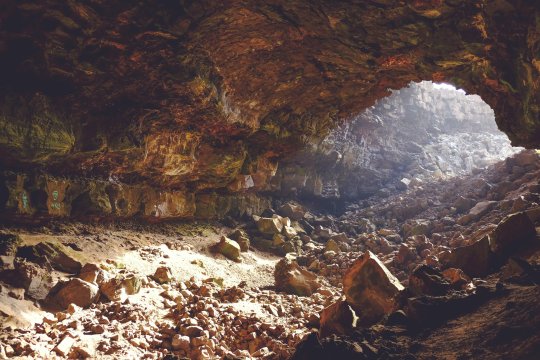
In a cave just south of Lisbon, archaeological deposits conceal a Paleolithic dinner menu. As well as stone tools and charcoal, the site of Gruta de Figueira Brava contains rich deposits of shells and bones with much to tell us about the Neanderthals that lived there—especially about their meals. A study published in Frontiers in Environmental Archaeology shows that 90,000 years ago, these Neanderthals were cooking and eating crabs.
"At the end of the Last Interglacial, Neanderthals regularly harvested large brown crabs," said Dr. Mariana Nabais of the Catalan Institute of Human Paleoecology and Social Evolution (IPHES-CERCA), lead author of the study. "They were taking them in pools of the nearby rocky coast, targeting adult animals with an average carapace width of 16cm. The animals were brought whole to the cave, where they were roasted on coals and then eaten." Read more.
496 notes
·
View notes
Text

First tyrannosaur fossil discovered with its last meal perfectly preserved in its stomach
Researchers have found a tyrannosaur’s last meal perfectly preserved inside its stomach cavity.
What was on the menu 75 million years ago? The hind legs of two baby dinosaurs, according to new research on the fossil published Friday in the journal Science Advances.
Dinosaur guts and hard evidence of their diets are rarely preserved in the fossil record, and it is the first time the stomach contents of a tyrannosaur have been uncovered.
The revelation makes this discovery particularly exciting, said co-lead author Darla Zelenitsky, a paleontologist and associate professor at the University of Calgary in Alberta.
“Tyrannosaurs are these large predatory species that roamed Alberta, and North America, during the late Cretaceous. These were the iconic apex or top predators that we’ve all seen in movies, books and museums. They walked on two legs (and) had very short arms,” Zelenitsky said.
“It was a cousin of T. rex, which came later in time, 68 to 66 million years ago. T. rex is the biggest of the tyrannosaurs, Gorgosaurus was a little bit smaller, maybe full grown would have been 9, 10 meters (33 feet).”
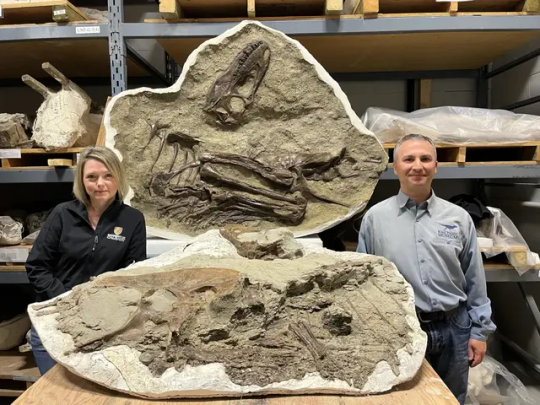
The tyrannosaur in question, a young Gorgosaurus libratus, would have weighed about 772 pounds (350 kilograms) — less than a horse — and reached 13 feet (4 meters) in length at the time of death.
The creature was between the ages of 5 and 7 and appeared to be picky in what it consumed, Zelenitsky said.
“Its last and second-to-last meal were these little birdlike dinosaurs, Citipes, and the tyrannosaur actually only ate the hind limbs of each of these prey items. There’s really no other skeletal remains of these predators within the stomach cavity. It’s just the hind legs.
“It must have killed … both of these Citipes at different times and then ripped off the hind legs and ate those and left the rest of the carcasses,” she added. “Obviously this teenager had an appetite for drumsticks.”

The two baby dinosaurs both belonged to the species called Citipes elegans and would have been younger than 1 year old when the tyrannosaur hunted them down, the researchers determined.
The almost complete skeleton was found in Alberta’s Dinosaur Provincial Park in 2009.
That the tyrannosaur’s stomach contents were preserved wasn’t immediately obvious, but staff at the Royal Tyrrell Museum in Drumheller, Alberta, noticed small protruding bones when preparing the fossil in the lab and removed a rock within its rib cage to take a closer look.
“Lo and behold, the complete hind legs of two baby dinosaurs, both under a year old, were present in its stomach,” said co-lead author François Therrien, the museum’s curator of dinosaur paleoecology, in a statement.
The paleontologists were able to determine the ages of both the predator and its prey by analyzing thin slices sampled from the fossilized bones.
“There’s growth marks like the rings of a tree. And we can essentially tell how old a dinosaur is from looking at those, the structure of the bone,” Zelenitsky said.
Changing appetites of top predators
The fossil is the first hard evidence of a long-suspected dietary pattern among large predatory dinosaurs, said paleoecologist Kat Schroeder, a postdoctoral researcher at Yale University’s department of Earth and planetary science, who wasn’t involved in the research.
The teen tyrannosaur didn’t eat what its parents did. Paleontologists believe its diet would have changed over its life span.
“Large, robust tyrannosaurs like T. rex have bite forces strong enough to hit bone when eating, and so we know they bit into megaherbivores like Triceratops,” Schroeder said via email. “Juvenile tyrannosaurs can’t bite as deep, and therefore don’t leave such feeding traces.”
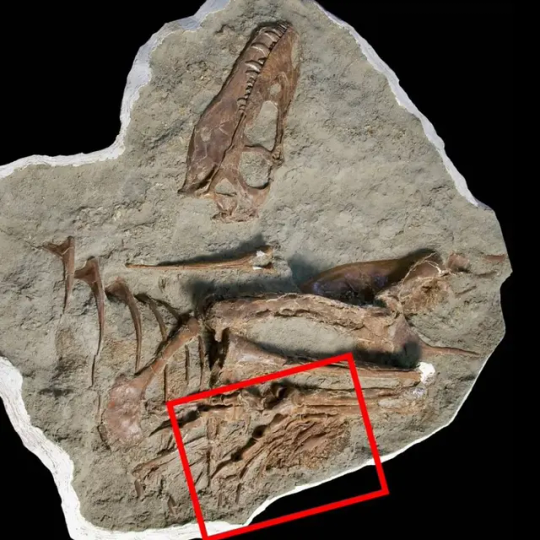
She said that scientists have previously hypothesized that young tyrannosaurs had different diets from fully developed adults, but the fossil find marks the first time researchers have direct evidence.
“Combined with the relative rarity of juvenile tyrannosaur skeletons, this fossil is very significant,” Schroeder added. “Teeth can only tell us so much about the diet of extinct animals, so finding stomach contents is like picking up the proverbial ‘smoking gun.’”
The contents of the tyrannosaur’s stomach cavity revealed that at this stage in life, juveniles were hunting swift, small prey. It was likely because the predator’s body wasn’t yet well-suited for bigger prey, Zelenitsky said.
“It’s well known that tyrannosaurs changed a lot during growth, from slender forms to these robust, bone-crushing dinosaurs, and we know that this change was related to feeding behavior.”
When the dinosaur died, its mass was only 10% of that of an adult Gorgosaurus, she said.
How juvenile tyrannosaurs filled a niche
The voracious appetite of teenage tyrannosaurs and other carnivores has been thought to explain a puzzling feature of dinosaur diversity.
There are relatively few small and midsize dinosaurs in the fossil record, particularly in the Mid- to Late Cretaceous Period — something paleontologists have determined is due to the hunting activities of young tyrannosaurs.
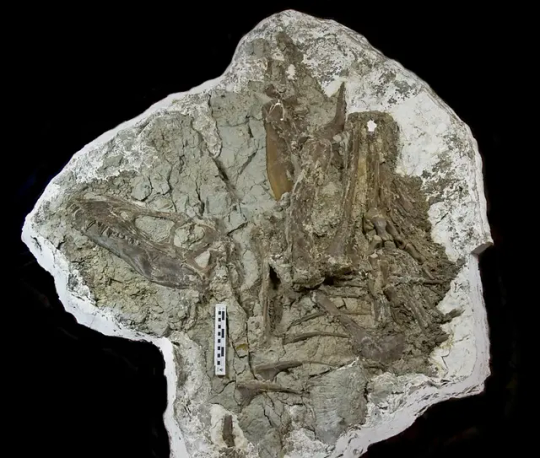
“In Alberta’s Dinosaur Provincial Park, where this specimen is from, we have a very well sampled formation. And so we have a pretty good idea of the ecosystem there. Over 50 species of dinosaurs,” Zelenitsky said.
“We are missing mid-sized … predators from that ecosystem. So yeah, there’s been the hypothesis that, the juvenile tyrannosaurs filled that niche.”
By Katie Hunt.


#First tyrannosaur fossil discovered with its last meal perfectly preserved in its stomach#tyrannosaur#Gorgosaurus libratus#Citipes#Citipes elegans#dinosaurs#paleontologist#Alberta’s Dinosaur Provincial Park#archeology#archeolgst#history#history news#ancient history
77 notes
·
View notes
Text
Why you should become a Paleoecologist, like Me!
Get to think about whole ecosystems, not just individual organisms
Look at the Big Picture and connecting it to Today!
No day on the job is the same!
There's so few of us there's not much competition!
Why you should NOT become a Paleoecologist, like Me!
too many variables, and most are lost to time
different fields of paleontology (bird, mammal, insect, flowering plant, non-flowering plant, etc.) have different standards, good luck figuring that out
Daily existential crises over the nature of time, space, matter, and energy
There's so few of us because we're all collectively going insane
Join Paleoecology Today! You'll lose your remaining sanity, but the moral high ground will always be yours!

249 notes
·
View notes
Text
Thalattosuchus and Leedsichthys
Quickly stopping by to report on a new paper describing stomach contents of a thalattosuchian (Jurassic marine crocodile).
The paper in brief describes a specimen of Metriorhynchus superciliosus (aka Thalattosuchus) with preserved stomach contents, which is already rare enough as is. What's even more interesting is that the stomach contents preserve both the gill rakes of the large fish Leedsichthys as well as various mollusc shells. Strange prey for what's a rather small piscivore. Although it was previously suggested that Metriorhynchus/Thalattosuchus attacked living Leedsichthys, this appears to have been based on missinterpreted evidence and given the enormous size difference its way more likely that the fish was simply scavenged, sorta like a kind of Jurassic whalefall. This actually finds support in the mollusc shells, which might have been ingested on accident alongside the fish remains.
Top left: The skeleton of this Thalattosuchus specimen
Top right: The stomach contents in detail (G are gill rakes, S are shells)
Bottom left: Live reconstriction of Thalattosuchus by Gabriel Ugueto
Bottom right: Live reconstruction of Leedsichthys by @knuppitalism-with-ue
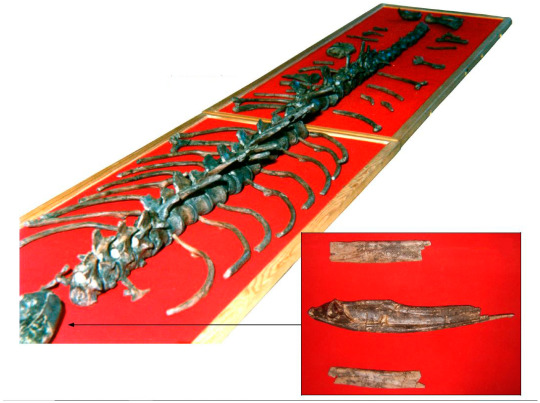
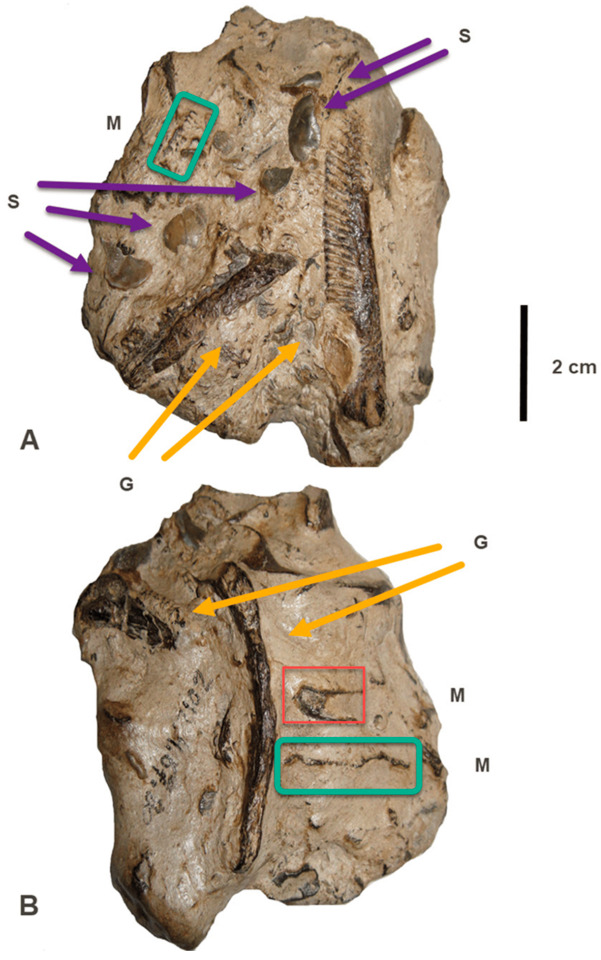
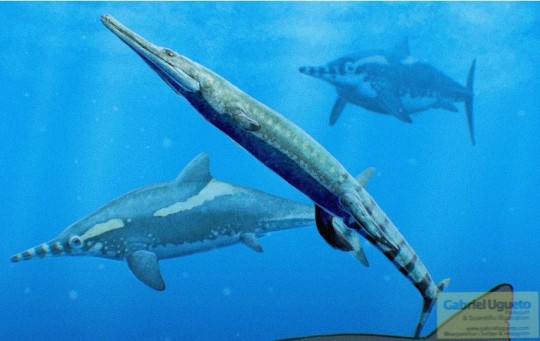

The paper itself:
Fossil Studies | Free Full-Text | The Diet of Metriorhynchus (Thalattosuchia, Metriorhynchidae): Additional Discoveries and Paleoecological Implications (mdpi.com)
#thalattosuchus#thalattosuchia#metriorhynchus#metriorhynchidae#leedsichthys#palaeoblr#paleontology#prehistory#jurassic
37 notes
·
View notes
Note
Hey I need some help, can you give me a list of carnivore dinosaurs that lived in forests??
Sorry, I'm not a list maker for hire ;)
The problem with your question is that forests usually don't preserve fossils. Most dinosaurs have been found in floodplain sediments, lakes, swamps, dunes or even marine sediments. So if they lived in forests they are usually found adjacent to them, not in them. That means we often times can't be sure if they really lived where they were buried.
In some cases, like the Jehol Biota, we know that the animals also lived there because here the animals are preserved in lakes and they were preserved very quickly in volcanic ash + the preserved plant fossils speak for a rich forest environment around the lakes.
What you have to do is look into the geology and paleobotany of the animals you have in mind. The formation articles on Wikipedia usually have a paleoecology/paleoenvironment section.
352 notes
·
View notes
Text
This is interesting. And for me, unexpected.
21 notes
·
View notes
Note
I will say, one disappointment I had with PP is they had an opportunity to show Hatezgopteryx hunting horse sized hadrosaurs and didn’t take it. Isn’t the prevailing theory that they were the main predator of Hateg Island? (Forgive the spellings I’m bad)
As far as we know they were the largest predator on Hațeg island by far, we've only theropods that have been found on the island have been troodontids, and there are some smallish crocodyliforms. That being said, for the pterosaur as a hunter it's a lot less costly in terms of energy to catch lots of small creatures that can be easily swallowed rather than try to catch larger prey.
Something that does stick out to me with Hatzegopteryx is that it doesn't really,, have anything that can grab and hold large prey? Like, theropods had sharp teeth or large claws, modern predatory theropods have talons and hooked beaks. Hatzegopteryx had a long pointed beak, and that seems much better adapted for snatching small prey like a heron rather than, I guess, trying to stab a horse sized animal to death? Of course when I say "small prey" I mean like, the size of a human.
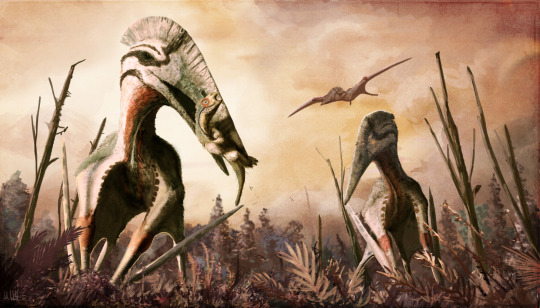
That's a Zalmoxes but it's still probably like, 2 metres long. Art by Mark Witton from an excellent blog post about Hatzegopteryx that does argue for the apex predator niche
Ok so I had intended to answer this question with just like, "it could've been interesting but I think when we got is fine and if a second season happens there's potential there" but now I've gone down a rabbit hole cause like, the more I think about it the more strange Hatzegopteryx seems as a candidate for an apex predator? I'm gonna page in @raptorcivilization to see what they think about the whole thing but like, Hatzegopteryx doesn't seem to have a method for grabbing and holding large prey, despite having a more robust head and body I'm kinda doubtful about the idea of it taking down the larger herbivores of the region.
#pterosaur#prehistoric planet#prehistoric planet spoilers#paleontology#paleomedia#paleoecology#palaeoblr
102 notes
·
View notes
Text
Bog day!

View On WordPress
0 notes
Text


KNOWN ALIASES, PART TWO:
Over the years, River has taken up many new aliases out of necessity, Sister Cantica, Miss Spritz, River Allegro. The list is as endless as it is frankly, obvious, which serves the dual purpose of being easy to remember and, a private joke she can enjoy. Of the many, many names, there are four that she finds herself coming back to over the years.Though these particular aliases are active for a long period of time, it does not mean that she lived linearly, keeping careful note of when it was safe to jump back and forwards between her own time-stream.
Here are the final two of those aliases ...
ALLEGRA MARLOWE verse; Post Library ( arc: I could take the whole world with me. )
Name meaning: Allegra typically means joy or lively in the original Italian. She chose it for it's semblance to Allegro however. ( musical term ) Marlowe she chose for it's French origins, meaning from the hill by the lake.
Occupation: Anthropologist
Qualifications: Doctorate in Anthropology, University of Edinburgh
Time zone: Europe/Asia 1980-2008
Nationality: Scottish.
Fictional Biography: Allegra comes from a very loving home in Scotland, where her mother supposedly still resides. She is most probably human ( her words ) and not not from around here. Allegra loves to travel and claims she has a rich benefactor which explains the houses in her name dotting the coast lands from the Greek islands all the way down to the Maldives. Her favourite home however is a small yacht she purchased to travel in, which is almost always hosting a party onboard. Despite her lifestyle and her openness to embrace new friends, little is truly known about Allegra. She died in 2008 on June 6 when Soputan erupted in Sulawesi, her body never recovered. Some say a flying saucer passed over head that same day.
NIAMH BERTRUN: verse; Post Library ( arc: Gloria, did you finally see that enough is enough? )
Name meaning: In Irish mythology, Niamh is the daughter of the god of the sea. Bertrun from the ancient Germanic name means secret lore. Put together, the literal translation is, secret song.
Occupation: Museum Curator.
Qualifications: Double degree in Archaeology and Paleoecology, Queen's University, Belfast.
Time zone: Ireland 2010 -2026.
Nationality: Irish.( Born in Zimbabwe )
Fictional Biography: Unlike Allegra, Niamh was quiet, reserved, the kind of woman who entered a room last, and left first. Little is known about her save two facts. Niamh Bertrun doesn't let anyone close enough to know her truths, and she certainly wouldn't want to. A museum curator by trade, she has scarcely left Ireland. Indeed the furthermost point she's gone is to travel down to Dublin where she now resides. She owns a house in the country, away from everyone and everything. She went missing over a weekend in late May of 2026, her absence only missed the following Monday when she failed to turn up at the Museum. Her colleagues reported her missing and it was thoroughly investigated by police, but the trail ran cold. Curiously, footage has unearthed nearby of a police box appearing beside the local pub around the time she disappeared.
#i made a garland for her head. and bracelets too. and fragrant zone; ... headcanons#she took on the alias of Niamh when she left Luna. after everyone around her had long died off.#i'm an archqueueologist from the future. i dug you up ! ... queue
5 notes
·
View notes